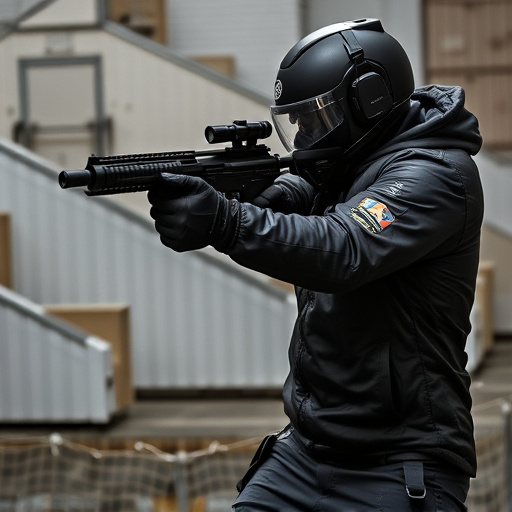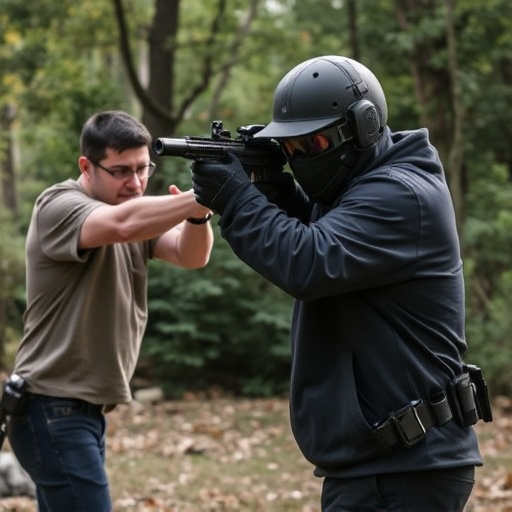The neuromuscular effects of stun devices, which disrupt nerve signaling with high-voltage, low-current pulses, are crucial for their disabling capability. Voltage range is key, with higher levels inducing quicker incapacitation but requiring careful handling to avoid safety risks. Regulatory guidelines and user training are essential to ensure safe and effective use of stun devices, balancing their neuromuscular impact against potential hazards.
“The neuromuscular effects of stun devices have sparked interest in personal safety enthusiasts and law enforcement alike. This article delves into the intricate workings of these devices, focusing on their voltage range and its critical role in effectiveness. We explore how stun guns temporarily incapacitate targets through neuromuscular disruption, highlighting key safety specifications and regulatory guidelines. Understanding these aspects is essential for users to deploy stun devices responsibly, ensuring both personal safety and legal compliance.”
- Understanding Neuromuscular Effects: How Stun Guns Disabilitate
- Safety Specifications: Voltage Range and Its Impact on Device Effectiveness
- Regulatory Considerations and User Training for Safe Stun Gun Operation
Understanding Neuromuscular Effects: How Stun Guns Disabilitate

The neuromuscular effects of stun devices are what make them effective in disabling an assailant. These devices work by delivering a high-voltage, low-current electrical pulse to the body, disrupting the neuromuscular transmission process. The electric current interferes with the nerve signals that control muscle movement, causing temporary paralysis and loss of balance in the targeted individual. This disruption is often sufficient to allow for escape or neutralization of the threat.
Stun guns operate by targeting specific nerve pathways in the body, particularly those responsible for controlling voluntary muscles. The electrical pulse disrupts the flow of ions within the nerves, leading to a cascade of biochemical events that result in muscle contraction and subsequent relaxation. This rapid and repeated cycle exhausts the victim’s muscles, rendering them unable to function effectively, thus providing a crucial window of opportunity for self-defense or law enforcement intervention.
Safety Specifications: Voltage Range and Its Impact on Device Effectiveness

The voltage range of a stun gun is a critical safety specification that directly influences its effectiveness as a neuromuscular disabling device. Stun devices are designed to temporarily incapacitate an assailant by delivering an electric shock that disrupts their neuromuscular system, causing muscle spasms and loss of balance.
Within the voltage range, each stun gun model has specific settings that determine its impact on the target. Higher voltages generally result in more intense neuromuscular effects, leading to quicker incapacitation. However, excessive voltage can pose safety risks, such as over-stimulation or even permanent damage if used improperly. Therefore, understanding the device’s voltage range and corresponding effects is crucial for responsible use and ensuring safety during self-defense situations.
Regulatory Considerations and User Training for Safe Stun Gun Operation

Regulatory considerations play a vital role in ensuring safe stun gun operation. Different regions have varying laws and regulations regarding stun devices, with many requiring permits or licenses for ownership and use. These regulations often outline specific voltage ranges that are permitted, focusing on minimizing risks associated with excessive voltage levels. For instance, the neuromuscular effects of stun devices at higher voltages can cause severe muscle contractions and even respiratory distress in some individuals, necessitating safety measures to prevent such adverse outcomes.
User training is another critical aspect for safe stun gun operation. Proper training ensures users understand the device’s functionality, voltage range, and potential side effects. It equips them with the knowledge to use the stun gun effectively while mitigating risks. Training should cover proper targeting techniques, safe distance maintenance, and post-stun care, including monitoring the subject for any signs of distress or medical complications resulting from the neuromuscular effects of stun devices.
Understanding the neuromuscular effects of stun devices is paramount for safe operation. Knowing that these devices temporarily incapacitate through high voltage shocks, users must be cognizant of their power range—typically between 50,000 to 120,000 volts—to ensure effectiveness while minimizing risks. Regulatory guidelines and proper user training are essential companions to this knowledge, promoting responsible and safe use of stun guns in dire circumstances.
